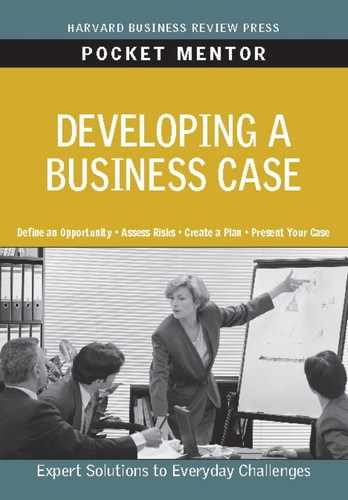Step 7:
Communicate
Your Case

You’ve crafted an implementation plan for your proposed course of action. Now it’s time to take the final step in developing your business case: communicating it to decision makers. Keys to this step include understanding your audience and presenting your business case effectively, including making smart use of visuals.
Understanding your audience
Building a business case is hard work. You may feel tempted to explain every detail of all that work to your decision makers while presenting your case to them. Resist that urge. In presenting your case, you want to deliver a short, focused sales pitch, not a lengthy, detailed lecture—even if your written business case contains rich detail.
Who will decide whether to approve your proposed solution? You’ll need to sell your case to the decision makers—and to those who influence them. The following tactics can help you:
• Clarify what you want them to do. What do you want from each individual in your audience? Do you want them to approve resources? Do you want them to talk up your proposal to others? Clearly state your need.
• Identify what they value and care about most. Do they care about ROI? Customer satisfaction? Some other measurement of business performance? You identified your stakeholders’ business objectives early in the process of building your business case. Now tailor your pitch to highlight the expected results and metrics that are most important to each decision maker.
• Articulate what they stand to gain. Explain how your audience will benefit if your idea is implemented. For example, perhaps the vice president of sales will get his staff up to speed more quickly or exceed sales targets if your recommendation is put into action.
• Assess their level of risk tolerance. Demonstrate that you’ve considered the risks inherent in your proposed course of action, and explain your plan for mitigating them.
• Determine how they like to receive information. What does your audience or your company require for written business cases in terms of format and level of detail? Do the decision makers want cases summarized in three slides—or in a two-page, single-spaced document? Will they require a copy of your case before meeting with you to hear your presentation? Find out, and then give them what they want.
Using visuals to present your case
Check with your finance, strategy, or human resources department to see if your company requires a certain layout for business cases. If it doesn’t specify a desired format, you can use the business case template provided in the Tips and Tools section of this book. Even if your company only requires a written document for each business case, consider also creating a visual presentation to help sell your idea.
Put the argument into a concrete shape . . . round and solid as a ball, which they can see and handle and carry home with them, and the cause is half won.
—Ralph Waldo Emerson
When created effectively, slide presentations help focus your audience’s attention. Because viewing too many slides can be overwhelming to your audience, keep slides to a minimum. Use no more than seven slides to make your case. The slides you’ll want to include correspond approximately to the steps you followed to build your business case:
• Slide 1: The opportunity statement
• Slide 2: The two or three alternatives you considered, as well as the business objectives and performance metrics you chose to measure your alternatives against
• Slide 3: A summary of the costs and benefits you considered
• Slide 4: Your initial recommendation and why you chose it
• Slide 5: The risks associated with this recommendation and how you plan to mitigate them
• Slide 6: The high-level milestones you expect to achieve and dates when the organization will realize benefits; persons accountable for each milestone; and resources needed for each milestone
• Slide 7: A reiteration of why the opportunity is important and how your recommendation will benefit your organization, including its impact on business results
Don’t include formulas and calculations in your slides. Instead, create a few backup slides containing this information, in case someone in your audience asks about them. Listeners tend to lose track of the main idea when the presenter gets too focused on small details. Plan to walk your audience through the presentation and then take time to go more in depth if people have questions.
Be sure to have all your backup information well organized and easily accessible so you are prepared for questions during and after your presentation.
“Tips for writing your business case” provides more ideas for this step.
